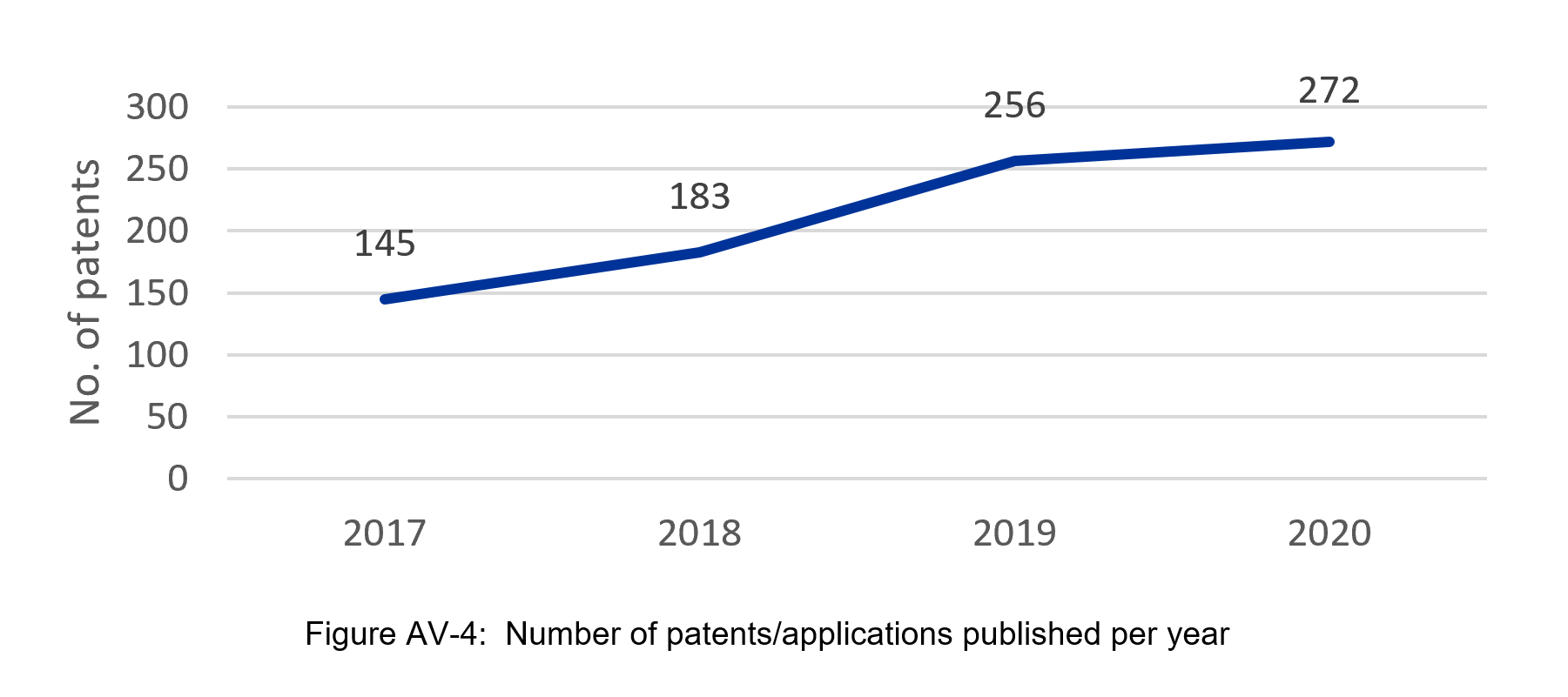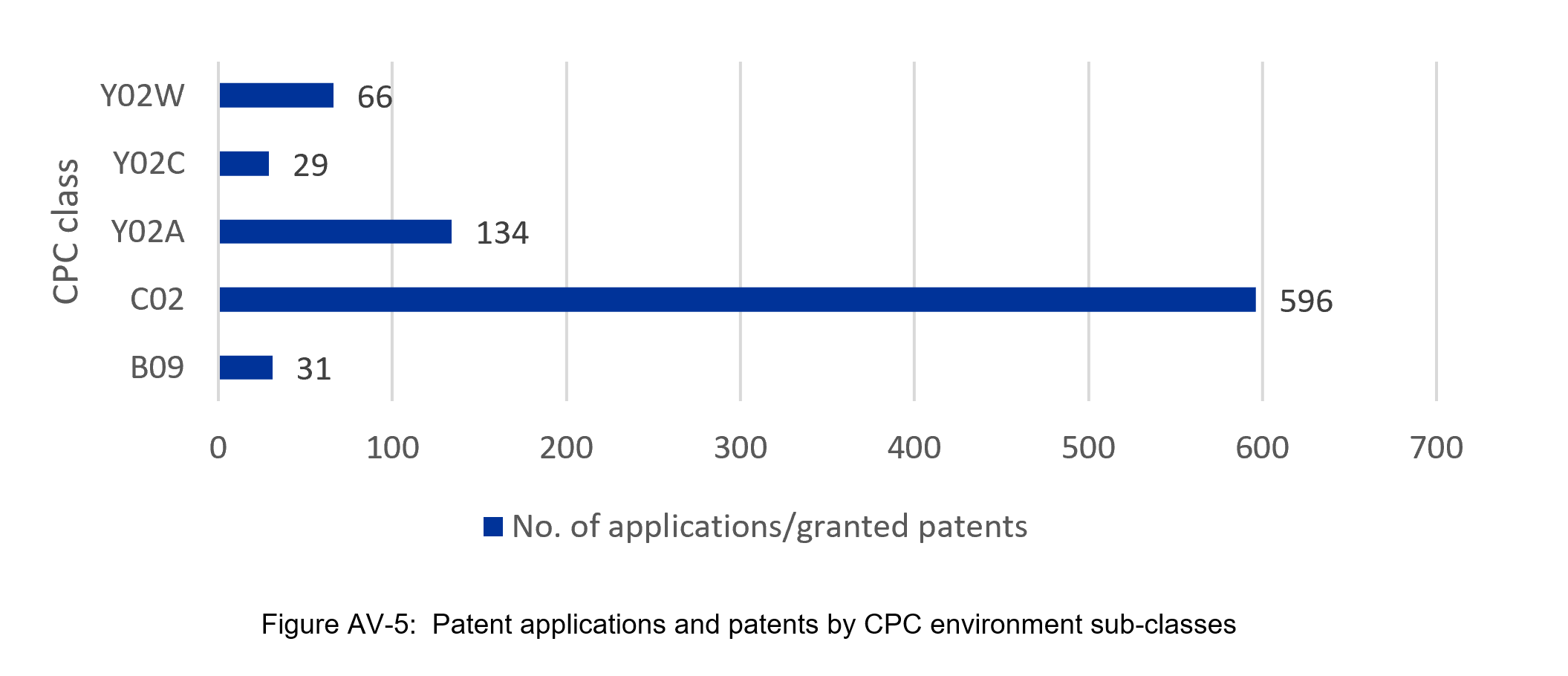Patents - EUON
Environment
Overview
This section looks at patenting activity in the field of nanotechnology and environment between 2017-2020. Granted patents and patent applications focused on environment and nanotechnology were extracted from the general collection of nanotechnology patents from 2017-2020 developed by the study team for the database. The patents were collected from Espacenet database maintained by the European Patent Office.
The dataset of patents on environment and nanotechnology was developed by extracting the granted patents and patent applications that contained the CPC classes and sub-classes dedicated to environment in their bibliographic information. It should be noted that most nanotechnology patents contain multiple classes in their subject descriptions. Environment referred to as a set of environment protection activities. In CPC such activities are covered under B09, C02 classes and several relevant sub-classes under Y02 class. The study did not cover sub-classes that were focused on the mitigation of climate change in specific sectors, such as construction, transportation and others by introducing more sustainable processes or features. Usually, patents/applications in such cases had CPC classifications for the respective sectors that were discussed in other parts of the study.
| Table AV-2: Environment in the Cooperative Patent Classification (CPC)1 | |
|---|---|
| Class | Title |
| B09 | Disposal of solid waste; reclamation of contaminated soil |
| C02 | Treatment of water, wastewater, sewage, or sludge |
| Y02A | Technologies for adaptation to climate change |
| Y02C | Capture, storage, sequestration or disposal of greenhouse gases |
| Y02W | Capture, storage, sequestration or disposal of greenhouse gases |
Environment in nanotechnology patents
As a result of patent collection mining, 856 patent applications and granted patents published from 2017-2020 were identified. The number of patents and patent applications containing environment classifications steadily increased each year.

Most patents (723, 85%) were published in the national patent offices, while the rest in the World Intellectual Property Organisation (WIPO, 126, 15%) and the European Patent Office (7, 1%).
China (596 applications, 70%) prevailed among the countries where most patent applications were published. Other countries, such as the USA, Australia, South Korea and Russian Federation, were in top five by the number of published applications, but significantly lagged behind China.
| Table AV-3: Top five countries by filed patents/applications in environment and nanotechnology in 2017-2020 | |
|---|---|
| Country | No. of patents/patent applications, % |
| China | 596, 70% |
| USA | 67, 8% |
| Australia | 16, 2% |
| South Korea | 15, 2% |
| Russian Federation | 8, 1% |
Patent applications and granted patents contained five CPC sub-classes referring to environment. The overwhelming majority of patents and applications focused on applications of nanotechnology for treatment of water, wastewater, sewage, or sludge (C02, 596, 70%).

Patents and applications dedicated to other fields were much less visible. However, technologies for adaptation to climate change (Y02A) received some attention – 134 patents and applications (16%).
| Table AV-4: Examples of patent applications and patents focused on C02 sub-class | |
|---|---|
| Bibliographic information | Abstract |
| Shao, P. et al. (2020). Device for pretreating complex heavy metals in electroplating cleaning wastewater by utilizing catalytic oxidation method and using method of device. Patent no. CN111847626A. Available here. (Patent application) | The invention discloses a device for pretreating complex heavy metals in electroplating cleaning wastewater by utilizing a catalytic oxidation method and a using method of the device, and relates to advice for pretreating electroplating cleaning wastewater and a using method thereof. The invention aims to solve the technical problem that complex heavy metal degradation effect is poor in the prior art. According to the invention, three folded plates are arranged in an oxidation decomplexing tank, and inflow water flows among the three folded plates in a zigzag mode to form a plurality of small vortexes, so the reaction efficiency of a catalyst and an oxidizing agent is improved, a reaction rate between singlet oxygen generated by interaction of the catalyst and the oxidizing agent and pollutants is increased, and the singlet oxygen and the pollutants realize sufficient reaction; the concept of multi-stage reaction and relay oxidation is provided by the invention, and dosing ports are formed in the first three intervals; a double-effect recovery tank is formed by coupling principles of an electrolysis gas flotation method and an electrolytic reduction method, and can be used for simultaneously and efficiently recovering the catalyst and elementary substances of complex heavy metal in the electroplating cleaning wastewater to be treated. |
| Ni, Q. J. et al. (2020). Highly selective alicyclic polyamide nanofiltration membrane and making method thereof. Patent no. US10780401B2. Available here. (Granted patent) | The present invention discloses a highly selective alicyclic polyamide nanofiltration membrane and a making method thereof. The method comprises the following steps: alternately and uniformly coating at least an alicyclic acid chloride solution and at least an alicyclic amine solution on a porous support membrane, using a spin coating method or a soaking method, to form at least one layer of the alicyclic polyamide nanofiltration membrane. Preferred embodiments exhibit improved ion selectivity, e.g. increased water flux, enhanced divalent/monovalent rejection selectivity, reduced fouling and improved divalent rejection rate (Ca2+, Mg2+) compared to the traditional aromatic-alicyclic mixed-structure polyamide nanofiltration membrane and/or the whole aromatic polyamide nanofiltration membrane. Therefore, the alicyclic polyamide nanofiltration membranes made in the present invention has great application prospect in the fields of zero-liquid discharge of industrial wastewater, water softening, and produce water treatment, etc. |
Environment innovation breakthroughs in patents
Innovation breakthrough is a particular type of innovation that has a profound effect on subsequent inventions, products and services. Three indicators of patents were studied to identify innovation breakthroughs – number of forward citations, number of citing organisations and number of citing countries.
In the analysis of patents and patent applications published between 2017-2020, one patent application out of 48 breakthrough patents addressed environment issues. The application was prepared by Massachusetts Institute of Technology (MIT, USA). The application received 15 citations from thirteen organisations located in five countries. This application also falls under the category of health.
| Table AV-5: Breakthrough patent application in environment | |
|---|---|
| Bibliographic information | Abstract |
| Veneziano, R. et al. (2017) Stable Nanoscale Nucleic Acid Assemblies and Methods Thereof. Patent no. WO189870 A1. Available here. | Methods for the top-down design of nucleic acid nanostructures of arbitrary geometry based on target shape of spherical or non-spherical topology are described. The methods facilitate 3D molecular programming of lipids, proteins, sugars, and RNAs based on a DNA scaffold of arbitrary 2D or 3D shape. Geometric objects are rendered as node-edge networks of parallel nucleic acid duplexes, and a nucleic acid scaffold routed throughout the network using a spanning tree formula. Nucleic acid nanostructures produced according to top-down design methods are also described. In some embodiments, the nanostructures include single-stranded nucleic acid scaffold, DX crossovers, and staple strands. In other embodiments, the nanostructures include single-stranded nucleic acid scaffold, PX crossovers and no staples. Modified nanostructures include chemically modified nucleotides and conjugated to other molecules are described. |
1 European Patent Office. (2022). Cooperative Patent Classification, A: Human necessities agriculture. Available at: https://www.cooperativepatentclassification.org/sites/default/files/cpc/scheme/A/scheme-A.pdf


